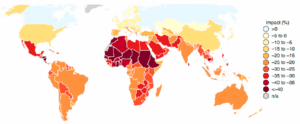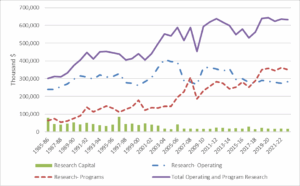The Shifting Global Context Needs Agriculture and Agri-food Innovation in Canada
Author(s):
Al Mussell
Douglas Hedley
Ted Bilyea

Disclaimer: The French version of this text has been auto-translated and has not been approved by the author.
Keywords: Agriculture; Research; Policy; Food security; Strategic investment; Innovation
Remarkable innovations are possible from basic agricultural research, and Canadian agricultural research can claim some major successes. However, the funding of basic agricultural research in Canada by provincial and federal governments has waned. It presents a widening gap between the needs and opportunities for agricultural research in Canada, and the shifting global food security situation- and Canada’s place in it.
Food is increasingly scarce in the world, beginning with staple grains. As Figure 1 shows, global grain (wheat and coarse grains) consumption in food, feed, and other uses has been growing since 2016/17 at a faster rate than global production. The gap has been filled by drawing down global stocks, and has left an increasing number hungry. The most recent Global Report on Food Crises reported that “acute food insecurity and malnutrition rise for sixth consecutive year in world’s most fragile regions” and that “more than 295 million people across 53 countries and territories experienced acute levels of hunger– an increase of 13.7 million from 2023.” Conflict in many parts of the world, stresses of weather extremes on agricultural systems, and economic shocks were identified as the proximate causes.
Figure 1 Global Grain Consumption and Ending Stocks

Source: International Grains Council
In turn, this has contributed to significant global food price inflation. In April, 2025 the real (inflation-adjusted) global food price index published by the UN-FAO was 117.5- which exceeds the level observed of 117.1 in 1973- in the early stages of the energy and food crisis of the 1970’s. Increasing international demand for food, and increasing prices, have increased the size of Canadian agri-food economy. Compared with 2015-18 averages, the most recent four years have seen a 49 percent increase in the value of Canadian agri-food exports, and a 42 percent increase in Canadian farm cash receipts.
Agricultural production continues to grow globally, but the rate of growth is slowing. Among the reasons for this is decreasing growth in agricultural total factor productivity, exacerbated by the adverse effects of climate change. According to the USDA1, the average annual rate of global agricultural output growth fell from 2.7 percent in 2001-10 to 1.9 percent 2011-22; the average annual rate of agricultural total factor productivity growth fell from 1.95 percent to .97 percent. Meanwhile, climate change has had adverse effects on agricultural systems, especially in mid-latitude regions containing much of the global population, as illustrated in Figure 2. Canada is among very few countries whose agricultural total factor productivity growth is estimated to have actually improved as a result of climate change.
Moreover, Bilyea (2025) shows that Canada is among a very narrow set of countries with material net exports of agri-food products, and a large market share among net exports. The implication is that the job of feeding much of the world, where agricultural systems are withering under the effects of climate change and geo-political strains, will increasingly fall to a narrow subset of countries that are beneficiaries of climate change and have relevant scale relative to the demand- placing Canada in a unique position.
Figure 2 Estimated Impacts of Anthropogenic Climate Change on Agricultural Total Factor Productivity

Source: Reprinted from Ariel Ortiz-Bobea et. al.
Spending on public investment in agricultural research globally has increased in aggregate, but Ruane and Ramasamy (2023) observed that investment in high income countries has increased at a much slower rate than middle income countries, and that effectively it is China, India, and Brazil that account for most the growth in public agricultural research investment.
Figure 3 below illustrates public agricultural research spending in Canada, based on provincial and federal expenditures. The figure shows that total expenditures on public operating and programmatic agricultural research have ranged around $600 million since the early 2000’s, but there has been a structural shift in favour of research program expenditure and away from internal research in government research stations. Moreover, capital expenditures in research are in decline. The implication is that the non-programmatic longer-term research and the expenditure for facilities to conduct it are in decline, with program-funded research- which is shorter-term in nature- increasing.
Figure 3 Government Expenditures in Support of the Agri-Food Sector, By Category, Canada

Source: Agriculture and Agri-Food Canada
The productivity effects of agricultural research are characterized by long lags, perhaps measured in decades. This presents the prospect that stalled or decreasing funding of public agricultural research today will project long into the future in falling productivity rates, just as today’s rate of annual output growth (recently estimated by the OECD2 for Canada at just over 2 percent/year for 2011-21) and agricultural total factor productivity (estimated at just over 1 percent/year, 2011-21) is a function of the basic agricultural research efforts of past decades. More generally, lax funding of public agricultural research is inconsistent with a much larger Canadian agricultural economy, and one that faces unique opportunities in the shifting geo-political and climate change context. It is equally inconsistent with private sector investment in more applied agricultural research and focused innovation in Canada that builds upon a base of basic public agricultural research.
Canada faces an important, distinct opportunity. The world is hungry, many are in desperate need, and the need will grow. There are few countries with the agricultural capacity and outlook for climatic stability that can be a material provider of exportable surpluses of agri-food products. Economic shocks, both driven by a less friendly international trade environment and a cause of protectionism, have left food importing countries more exposed and in greater need of trusted suppliers.
Canada has not augmented its basic agricultural research investment accordingly with this shifting context, and its existing agricultural output and total factor productivity growth is essentially riding on legacy public research investments, some made decades ago. At the same time, other countries- some of whom are competitors to Canada- have accounted for the bulk of public agricultural research globally, and are positioning themselves to surpass Canada. Canada is unlikely to see transformative agri-food innovation, such as the development of canola from rapeseed, unless it is prepared to reinvest in longer-term internal research in government research stations, and in the associated capital infrastructure. Renewing a commitment to increased public agricultural research in Canada, linked to research establishments around the world, should thus be both a strategic, as well as a technical, priority for Canada.
1 See International Agricultural Productivity – Summary Findings (https://www.ers.usda.gov/data-products/international-agricultural-productivity/summary-findings)
2 OECD Network on Agricultural Total Factor Productivity and the Environment (https://www.oecd.org/en/networks/network-on-agricultural-total-factor-productivity-and-the-environment.html)
References
Bilyea, Ted. 2025. Food: The undervalued asset in Canada’s Indo-Pacific Strategy. Canadian Agri-Food Policy Institute Perspective Report, May 2025. https://capi-icpa.ca/wp-content/uploads/2025/04/2025-04-01-Indo-Pacific-Perspective-Report-EN.pdf
Food Security Information Network and Global Network Against Food Crises. 2025. Global Report on Food Crises 2025. Food Security Information Network, Rome. https://www.fsinplatform.org/grfc2025
Ortiz-Bobea, Ariel, Toby R. Ault, Carlos M. Carrillo, Robert G. Chambers, and David B. Lobell. 2021. “Anthropogenic climate change has slowed global agricultural productivity growth”, Nature Climate Change (11) April 2021 306–312 https://www.nature.com/articles/s41558-021-01000-1
Ruane, J. and Ramasamy, S. 2023. Global investments in agricultural research: Where are we and where are we going? Food and Agriculture Organization of the United Nations, Rome. https://doi.org/10.4060/cc6971en

